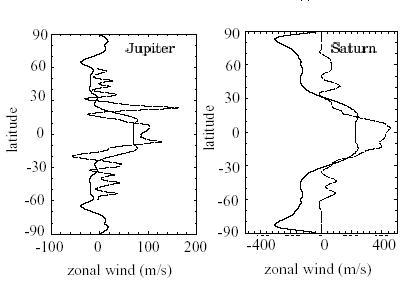The atmospheres of giant planets such as Jupiter have a thickness without common measure with that of the atmospheres of telluric planets. The circulation of the winds, known since the observations with a telescope of the motion of the Jupiter clouds, shows very different characteristics. In particular, differential rotation on these planets makes bands of clouds alternatively clear and dark turn at different speeds, the equatorial belt on Jupiter and Saturne moving more quickly than the average of the planet (implying prograde zonal winds, eastward directed). The first results of a meteorological model applicable to giant planets, developped by J.I. Yano (LMD, Laboratoire de Météorologie Dynamique de Paris, et CNRM, Toulouse), with the collaboration of O. Talagrand (LMD) and P. Drossart (LESIA, Observatoire de Paris), succeed to explain the origin of zonal winds.

The phenomenon of zonal winds, which is reproduced with difficulty in the traditional meteorological models with a thin layer, is reproduced here by a model of thick atmosphere, where the fluid layers are laid out according to embedded concentric cylinders crossing the planet. It is possible to show that this disposition modifies the variation of vorticity of the fluid with latitude, which involves the prediction of prograde zonal winds, contrary to the traditional models of vorticity with thin atmospheric layers. This model is only a first theoretical sketch on the way of a complete understanding of the atmospheric circulation of giant planets, which remains one of the mysteries of these planets. The observations of the Cassini probe (NASA/ESA) from 2004 should provide many observations which will constitute new tests for these meteorolocical models.

Référence
- J.I. Yano, Laboratoire de Météorologie Dynamique (Paris) et CNRM (Toulouse), O. Talagrand, Laboratoire de Météorologie Dynamique (Paris), P. Drossart, LESIA, Observatoire de Paris — "Origins of atmospheric zonal winds" Nature, 2 Janvier 2003, Brief Communication
Contact
- Pierre Drossart
Observatoire de Paris, LESIA
